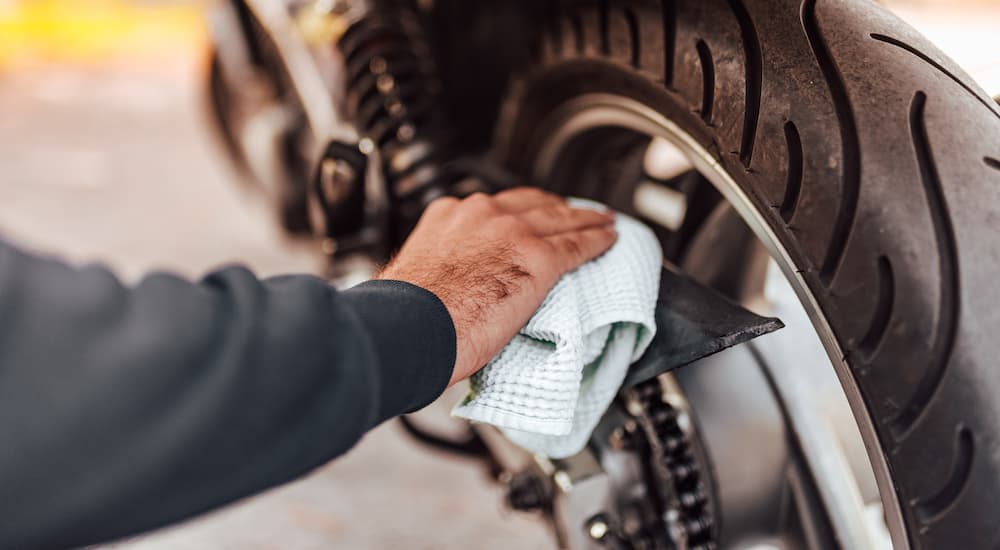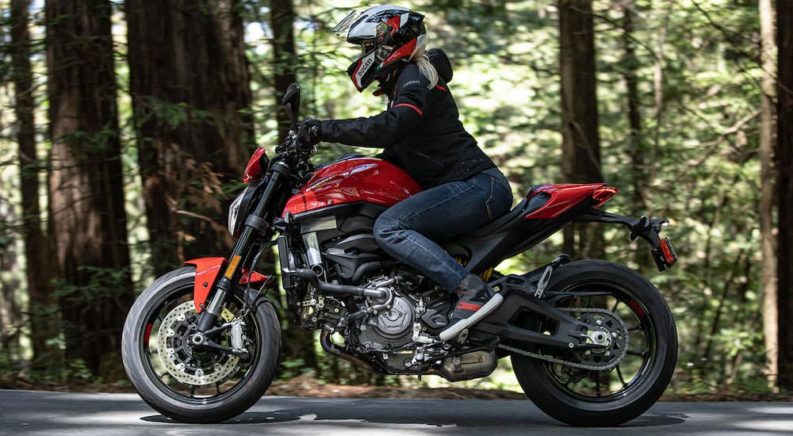How much thought do you give to the chain on your motorcycle? Motorcycle chain maintenance is integral to your bike’s performance and your safety in the saddle. The chain connects the engine and gearbox to the rear wheel, causing it to turn and move the motorcycle. The rear wheel on a middleweight motorcycle sees the same amount of power as a small car. This power is channeled through the chain, so you can see why ignoring it is a recipe for disaster. Here’s everything you need to know to avoid that disaster, from proactive chain inspections to lubrication and replacement.
Types of Chains
Before you can properly maintain the chain on your motorcycle, it’s essential to know what type of chain it is: unsealed or sealed. Many vintage motorcycles use unsealed chains, which you’ll also find on bicycles. Because these chains aren’t sealed, they require frequent lubrication to reduce friction. Even then, the chains wear quickly and need periodic replacement.
Sealed chains, like O-ring or X-ring chains, are standard on most modern motorcycles because they are more effective and longer lasting. They feature integrated rubber seals between the inner and outer links that keep grease inside and dirt, water, and other debris outside. As a result, sealed chains require less upkeep and lighter applications of lube to extend their longevity.
Cleaning
Because of its position and design, your motorcycle chain is directly exposed to the elements. As a result, it can easily become one of the dirtiest parts of your motorcycle. Traveling on dirt roads, through mud, or over sandy terrain can make matters worse, but that doesn’t mean you have to avoid these conditions. With proper cleaning, you can extend the life of your chain for many miles ahead.
Even with a sealed chain, dirt particles can find their way inside and mix with the oil, making the chain wear faster than necessary. Many riders think the quickest fix to clean their chain is to run a pressure washer over the chain as they wash the bike. Unfortunately, this can force water inside the rings. If you want your bike to perform its best and your chain to last, it takes a little know-how and a few minutes after your ride.
At the end of your ride, prop the bike up on a center stand or the side stand. Once the motorcycle is in position, spray the entire length of the chain with a cleaner. Never use a petroleum-based cleaner or detergent, but one specifically designed for cleaning the chain. Ideally, a spray-on rinse-off formula is best, but you can also use a chain wax that lubricates and cleans. If the chain is filthy, you can use a sponge, a soft nylon brush, or an old rag to clean the links before rinsing the chain with water.
Recommendations:
- Clean your chain every 400 to 800 miles.
- Never use wire brushes or petroleum-based cleaners.
- Never use high-pressure nozzles or pressure washers.
Lubricating
Once your chain is clean, it’s ready for lubrication. Never lubricate your chain before a ride, but after. The heat from the chain will absorb the lubricant, allowing it to penetrate better, and you won’t have to clean as much lubricant off your bike. Also, having time between lubricating and your next ride allows the solvents in the lubricant to evaporate. How do you apply the lubricant?
Lubricating the chain is easy and requires the same position using the center or side stand. Ideally, the center stand is best since you need to be able to rotate the rear wheel. Once the bike is in position, spray the chain with a thin, even coating of chain lube. As you apply the lubricant, spin the wheel until the chain has made several revolutions to ensure that every link is properly protected.
The most challenging part of lubricating a motorcycle chain is deciding the type of lubricant to use. Lubricants come in various forms, like chain wax and chain lube, and are designed to do the same job––to clean the chain, repel water, and extend the chain’s lifespan by minimizing wear and tear. Choosing the best lubricant comes down to personal preference. For example, chain lube typically comes as an aerosol or spray and is easy to use since you simply aim the nozzle and spray. In contrast, chain wax comes in a toothpaste-like tube and is more time-consuming because you have to apply it with a brush. However, since it’s white in color, it’s easier to see where the wax has been applied.
Recommendations:
- Lubricate the chain every 400 to 800 miles.
- Chain lube is typically more efficient and easier to apply.
- Chain wax has a thicker consistency and stays in place longer.
Inspecting
Inspecting your motorcycle should be one of the things you do before any ride. A quick visual inspection can mean the difference between enjoying your ride and sitting stranded on the side of the road. What should you look for during a pre-ride inspection? Well, there are a lot of things that you should pay attention to, but one of the most important is the chain.
As you look at the chain, check the tension and free play at the bottom and see how it compares to the manufacturer’s recommendations outlined in your owner’s manual. When you pull straight back on the chain at the rear sprocket, does it pull away rather than hug the sprocket? If so, the chain is stretched out and needs to be replaced.
Tight spots also need attention and are evident when the chain doesn’t rotate freely as you turn the rear wheel. As you note these issues, look for side-to-side movement, how the links slide back and forth under tension, and rust spots. Rust is a telltale sign that the chain isn’t properly lubricated or that the chain lubricant you use doesn’t offer enough corrosion protection. Lastly, look for wear along the rear drive sprocket to ensure the teeth are not bent, curved, or hooked, resembling shark fins.
If it’s time for a new motorcycle chain, you have several options to get the job done. Some avid riders have all the tools they need in their garage, which makes the task incredibly easy. However, other riders don’t have these tools and are happy to let their local motorcycle service shop tackle the job. In any instance, we recommend replacing the chain and sprockets together to save valuable time and cut labor costs.
Recommendations:
- Look for chains that are too loose or not turning freely.
- Inspect the master link that joins the two ends to ensure it’s secure.
- Putting a new chain on a worn sprocket will shorten the life of the chain.

Proactive Maintenance
One of the biggest takeaways from maintaining your motorcycle chain is to make it a habit to inspect the chain before every ride. This inspection puts the chain within immediate view, letting you see potential issues before you get in the saddle. In turn, you can make the necessary repairs, clean and lubricate the chain, or plan for a replacement before the unthinkable happens and you’re stuck on the side of the road with no reliable way to get home.


